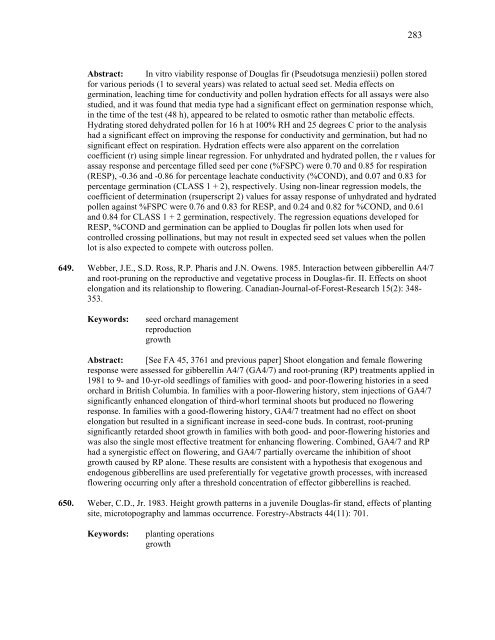IntensIve sIlvIculture - Forest Science Labs - Research Network ...
IntensIve sIlvIculture - Forest Science Labs - Research Network ...
IntensIve sIlvIculture - Forest Science Labs - Research Network ...
Create successful ePaper yourself
Turn your PDF publications into a flip-book with our unique Google optimized e-Paper software.
283<br />
Abstract: In vitro viability response of Douglas fir (Pseudotsuga menziesii) pollen stored<br />
for various periods (1 to several years) was related to actual seed set. Media effects on<br />
germination, leaching time for conductivity and pollen hydration effects for all assays were also<br />
studied, and it was found that media type had a significant effect on germination response which,<br />
in the time of the test (48 h), appeared to be related to osmotic rather than metabolic effects.<br />
Hydrating stored dehydrated pollen for 16 h at 100% RH and 25 degrees C prior to the analysis<br />
had a significant effect on improving the response for conductivity and germination, but had no<br />
significant effect on respiration. Hydration effects were also apparent on the correlation<br />
coefficient (r) using simple linear regression. For unhydrated and hydrated pollen, the r values for<br />
assay response and percentage filled seed per cone (%FSPC) were 0.70 and 0.85 for respiration<br />
(RESP), -0.36 and -0.86 for percentage leachate conductivity (%COND), and 0.07 and 0.83 for<br />
percentage germination (CLASS 1 + 2), respectively. Using non-linear regression models, the<br />
coefficient of determination (rsuperscript 2) values for assay response of unhydrated and hydrated<br />
pollen against %FSPC were 0.76 and 0.83 for RESP, and 0.24 and 0.82 for %COND, and 0.61<br />
and 0.84 for CLASS 1 + 2 germination, respectively. The regression equations developed for<br />
RESP, %COND and germination can be applied to Douglas fir pollen lots when used for<br />
controlled crossing pollinations, but may not result in expected seed set values when the pollen<br />
lot is also expected to compete with outcross pollen.<br />
649. Webber, J.E., S.D. Ross, R.P. Pharis and J.N. Owens. 1985. Interaction between gibberellin A4/7<br />
and root-pruning on the reproductive and vegetative process in Douglas-fir. II. Effects on shoot<br />
elongation and its relationship to flowering. Canadian-Journal-of-<strong>Forest</strong>-<strong>Research</strong> 15(2): 348-<br />
353.<br />
Keywords: seed orchard management<br />
reproduction<br />
growth<br />
Abstract: [See FA 45, 3761 and previous paper] Shoot elongation and female flowering<br />
response were assessed for gibberellin A4/7 (GA4/7) and root-pruning (RP) treatments applied in<br />
1981 to 9- and 10-yr-old seedlings of families with good- and poor-flowering histories in a seed<br />
orchard in British Columbia. In families with a poor-flowering history, stem injections of GA4/7<br />
significantly enhanced elongation of third-whorl terminal shoots but produced no flowering<br />
response. In families with a good-flowering history, GA4/7 treatment had no effect on shoot<br />
elongation but resulted in a significant increase in seed-cone buds. In contrast, root-pruning<br />
significantly retarded shoot growth in families with both good- and poor-flowering histories and<br />
was also the single most effective treatment for enhancing flowering. Combined, GA4/7 and RP<br />
had a synergistic effect on flowering, and GA4/7 partially overcame the inhibition of shoot<br />
growth caused by RP alone. These results are consistent with a hypothesis that exogenous and<br />
endogenous gibberellins are used preferentially for vegetative growth processes, with increased<br />
flowering occurring only after a threshold concentration of effector gibberellins is reached.<br />
650. Weber, C.D., Jr. 1983. Height growth patterns in a juvenile Douglas-fir stand, effects of planting<br />
site, microtopography and lammas occurrence. <strong>Forest</strong>ry-Abstracts 44(11): 701.<br />
Keywords: planting operations<br />
growth
















